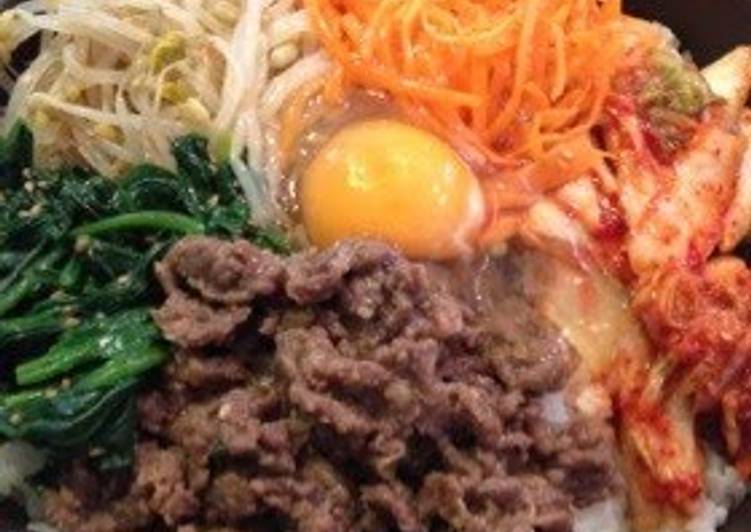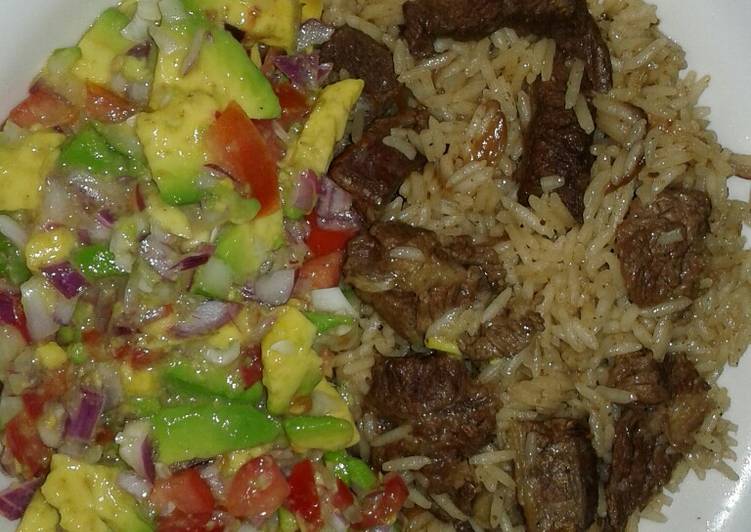
Hey everyone, it’s me again, Dan, welcome to my recipe page. Today, I’m gonna show you how to prepare a distinctive dish, addictive bibimbap made in a frying pan. It is one of my favorites food recipes. This time, I am going to make it a little bit unique. This will be really delicious.
Addictive Bibimbap Made in a Frying Pan is one of the most well liked of current trending foods in the world. It’s simple, it’s quick, it tastes delicious. It’s enjoyed by millions daily. Addictive Bibimbap Made in a Frying Pan is something which I’ve loved my entire life. They are fine and they look wonderful.
Bibimbap - it reminds me of Korean Airlines' delicious in-flight meal. The secret to making great Bibimbap everytime is the Gochujang sauce! Pan-fry the vegetables on a medium heat.
To get started with this particular recipe, we must first prepare a few ingredients. You can cook addictive bibimbap made in a frying pan using 13 ingredients and 13 steps. Here is how you cook it.
The ingredients needed to make Addictive Bibimbap Made in a Frying Pan:
- Get 3 rice bowl's worth Hot cooked white rice
- Make ready 1 bag Bean sprouts
- Get 1/2 bunch Spinach
- Prepare 1/2 Carrot
- Make ready 1 dash less than 1 rice bowlful Kimchi
- Get 200 grams Meat
- Prepare 1 Sesame oil
- Prepare 1 Sesame seeds
- Prepare 1 Egg
- Prepare 1 Doubanjiang
- Prepare 8 tbsp Yakiniku sauce (store-bought)
- Take 5 sheets Korean nori seaweed
- Prepare 2 tsp Chinese soup stock
Some cooking oil (for pan frying some vegetables). Bibim sauce (mix these well in a bowl.) Bibimbap - Korean mixed rice. Variety of components to choose from to prepare bibimbap, from Here is a little trick to make gorgeous sunny side up eggs without any hassle. Heat the oil over medium-high heat in a non-stick pan, until it.
Instructions to make Addictive Bibimbap Made in a Frying Pan:
- First, make the namul: Blanch the bean sprouts.
- Drain the blanched bean sprouts, put them in a bowl, and mix in 1 teaspoon of Chinese soup stock, 1 tablespoon of sesame oil, and 1 tablespoon of sesame seeds.
- Julienne the carrot, sprinkle on a 1 scant teaspoon of salt, mix, and set aside until the moisture comes out.
- Once the carrot is wilted, squeeze out the excess moisture, and mix in 1 tablespoon of sesame seeds, and 1 tablespoon of sesame oil.
- Boil the spinach, cut into bite-sized pieces, mix in 1 teaspoon of Chinese soup stock, 1 tablespoon of sesame oil, and 1 tablespoon of sesame seeds.
- Cook the meat halfway, pour in the yakiniku sauce, and cook through the meat. You could use ground meat instead.
- Heat a frying pan and pour in plenty of sesame oil (about 5 tablespoons).
- Once the frying pan is hot enough, add the rice. You should be able to hear the rice crackle and pop.
- Place each vegetable namul, kimchi and the meat on top, crack open 1 egg in the middle, and squeeze out about 1/2 teaspoon of doubanjiang to the side of the egg.
- Heat over medium to high heat without touching the frying pan. Flip over the rice from time to time to check to see if the rice is browned enough as shown in the photo.
- Sprinkle on Korean nori seaweed torn into small pieces, drizzle on the yakiniku sauce, and let it continue to cook briefly.
- Once the rice is browned and crispy, mix it all together.
- Done!
Bibimbap (BEE-bim-bap) is a bowl of warm white rice topped with an assortment of sauteéd and seasoned vegetables, gochujang (or other chili pepper Kimchi is not something one would typically see tossed in a Bibimbap bowl. However, kimchi is very Korean, so I imagine that kimchi would be, at. Pan-fry the bean sprouts in a few tablespoons of olive oil for a few minutes. Serve the bibimbap in bowls, starting with rice, topping it with the other prepared accompaniments and finishing each dish with a fried egg and a sprinkling of black sesame seeds. A Korean rice bowl packed with goodies - sliced steak, fried egg, spinach, carrot and toasted sesame seeds, plus gochujang or sriracha for a chilli kick.
So that’s going to wrap this up for this exceptional food addictive bibimbap made in a frying pan recipe. Thank you very much for your time. I’m confident that you will make this at home. There’s gonna be more interesting food at home recipes coming up. Don’t forget to save this page on your browser, and share it to your family, colleague and friends. Thank you for reading. Go on get cooking!


